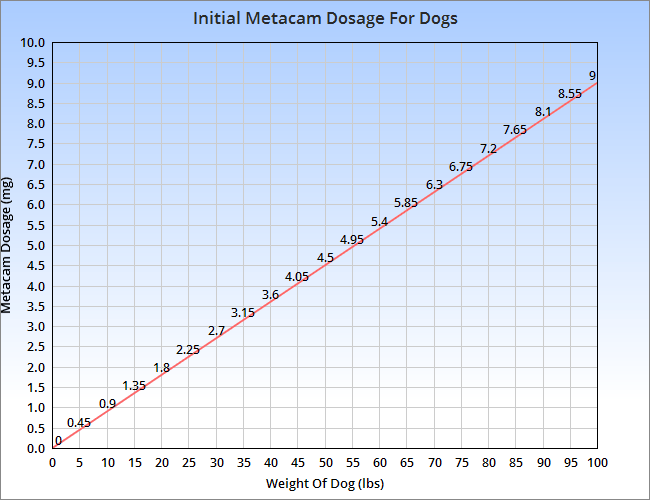What is Metacam for dogs?
Metacam, similar to Previcox, is a non-steroidal anti-inflammatory drug, or NSAID for short. These types of drugs are often given to dogs who are suffering from a variety of hip and joint pain, whether it’s as a result of osteoarthritis or another ailment.
The medication works to reduce the pain and inflammation that your dog is experiencing to help give them some added comfort and mobility. These symptoms occur either due to:
- disease
- injury
- or to degenerative wear and tear, that slowly breaks the cartilage that cushions joints down.
Once this is gone, nothing is there to act as a shock absorber or to prevent bones from rubbing up against one another, which can be incredibly painful!
How does Metacam work?

If you read our article about Previcox, then you know that it works as a COX-2 inhibitor. By stopping its production, the prostaglandins that cause the inflammation are also held back, which limits the pain that your pet experiences.
Metacam, however, works in a slightly different way. There are actually two forms of cyclooxygenase. We already discussed the second one, but the first, COX-1, has some beneficial properties. Production of prostaglandins from this enzyme serves to reinforce and protect the lining of the stomach to improve the functioning of the gastrointestinal tract.
A COX-1 inhibitor
It might seem counter-intuitive, then, that Metacam acts as a COX-1 inhibitor, rather than as a COX-2 inhibitor. It does this because COX-1 inhibitors are actually more effective at alleviating the pain caused by inflammation of the joints than their counterparts.
The downside is that when used in high enough doses, these inhibitors, like Metacam, can increase the likelihood of developing stomach ulcers in your dog since the mucous lining of the stomach is weakened due to the decrease in production of prostaglandins.
Thankfully, if your dog is only suffering from mild aches and pains, the dose should be small enough not to have any adverse effects on their digestive system, while still having beneficial effects on their aching bones and joints.
What conditions is Metacam used for?

Well, if your dog is beginning to display symptoms of osteoarthritis, then you don’t really have a choice. There is as of yet, unfortunately, no cure for the condition, so the focus is always on coping with it through the use of medication.
That means, in one form or another, you’ll pretty much be forced to turn to an NSAID of some sort. The difference, as we mentioned earlier, is in severity. Older dogs with weakened immune systems and sensitive stomachs are more likely to be prescribed a COX-2 inhibitor.
Joint pain doesn’t always target only the old, however. Many young dogs develop these symptoms due to degenerative conditions, and while the prognosis isn’t what you’ll want to hear, if the disease is identified early a COX-2 inhibitor can all but eliminate their pain, allowing them to enjoy the freedom of their younger years.
There are also some other cases where Metacam might come in handy. It has been known to have effects such as reducing fever, so it’s possible that following surgery or an infection that your dog is recovering from, he or she will be prescribed the medication to help speed up the recovery process.
Where to acquire Metacam for dogs

Like most medication for dogs, Metacam is handed out by prescription only, which means that it will only follow a veterinary examination. The drug might be given in external injury cases which cause inflammation and pain, or due to osteoarthritis.
The first should be easy enough for your vet to assess, but the second might be a little bit more complicated depending on the age of your dog and the frequency of your visits. Once there, your vet will probably test for soreness, limps, or pained sounds when being touched, all of which are critical signs of the disease.
Just note that the symptoms aren’t necessarily enough to walk out of the door with a prescription. Pets who are pregnant or too young might not qualify for the use of the medication since they need to be at least six months old before taking it, and preferably older.
Last but not least, don’t be surprised if the name on the paper isn’t what you’ve been reading about here. Metacam is the brand name of the drug, but it can also be given out under its generic name, meloxicam. Both variants are equally as effective and work in the same way, but certain vets have their own preferences and might be more likely to prescribe something different than brand names.
Things to tell your vet beforehand
The most important things you can tell your vet, especially if your dog is an otherwise healthy adult, are fundamental behavioral changes that might indicate that something is wrong.
Examples of this would include:
- lethargy or signs of depression (such as not wanting to play, go outside, or walk)
- changes to their dietary habits (reduced consumption of food)
- sudden aggression or a reluctance to be touched.
These symptoms aren’t easy for your vet to assess in short visits, so it’s crucial that you have that information prepped for your next appointment.
As always, other vital bits of information include a history of heart, kidney, and liver health, since these conditions are always the most prone to act up to new medication if they’re already unhealthy. It’s also wise to inform them of existing allergies or past reactions to other NSAIDs.
Finally, since we’ve established that Metacam is a COX-1 inhibitor, it can be pretty significant to mention any other symptoms that might indicate acid-reflux, such as:
- excessive burping
- bad breath
- pained whining.
If your dog is prone to the condition, then your doctor will most likely prescribe something else to avoid risking gastrointestinal upset and forcing you to hand out even more medication.
Metacam dosage for dogs

The great thing about Metacam is that it comes as a solution, rather than as a solid pill, which makes it extremely easy to measure and orally administer to your pet since dogs, surprisingly, don’t often object to the taste. Go figure.
It comes in four bottle sizes:
- 10 ml
- 32 ml
- 100 ml
- or 180 ml.
To make it even easier, however, the strength of the solution is always the same, and each ml of the product contains 1.5 mg of the drug. This makes it exceptionally easy to accurately measure out the medication, as opposed to breaking apart scored pills and storing them somewhere else.
The initial dose is always stronger than the first, and this is the standard procedure to quickly get the healing properties of the medication into your pet’s system. Most vets will advise that you start with .1-.2 mg per pound, and then halve that on subsequent days.
That means that a fifteen-pound dog will, conveniently, only require one ml of the product on the first day, and half an ml on the next. If you do the math, you can see that the larger bottles are cost-effective for smaller dogs.
How to dose with Metacam
Dosing your pet is remarkably easy due to the liquid nature of the drug. You don’t need to wrap the pill in a snack or coax your dog to take their meds, and the included dropper with most bottles of Metacam is quite reliable for accurately doling out the required amount of the solution.
However, since it’s rare that dogs will require entire droppers full of the drug (the math doesn’t often work out just that nicely, unfortunately), some care does need to go into carefully measuring the solution.
This could be time-consuming, but one trick around this is to measure out a full portion, and then to slowly drip it onto the food of your pet. Just make sure your pup finishes his meal if you should administer it this way.
For how long will my dog need the drug?
The period of time that your dog will be on the meds is slightly more complicated. As a pain-reliever for an injury, you can safely use it until your dog’s condition seems to have improved and the injury is no longer visible.
For osteoarthritis, however, the duration could be indefinite. Since there’s no cure for the source condition, dogs that are suffering from it will always require the use of NSAID to alleviate their pain.
Your vet might tell you otherwise, however, so as always follow their advice first.
In case of an overdose
If your dog overdoses on this drug, it could prove to be fatal, so always ensure you never give more than is recommended by your vet. Signs of a possible overdose include:
- diarrhea
- black stool (a sign of internal bleeding that should have you worried)
- vomiting
- possible jaundice.
Be sure to call or visit your vet immediately for advice and refrain from giving your dog additional doses of the medication until their condition has been assessed and he’s been given the all-clear.
Metacam for dogs side effects

Since it works the same way as any other NSAID at its core, it’s only natural that it shares similar side-effects. Of course, one beneficial effect you might observe is an increase in energy, but that’s not all you’re likely to see.
Their daily “bathroom routine” on their walks might change dramatically, and this could affect both their bowel and urinary movements, so be on the lookout for both. Increased urination can result in dehydration, so don’t be surprised if your dog starts to drink a lot more water, which continues the cycle of urination.
Aside from that, the big thing you need to watch for is the potential development of stomach ulcers as Metacam can have adverse effects on your pet’s digestive health. To stay one step ahead of the game, be sure to look out for the following:
- abdominal pain
- lack of appetite
- excessive diarrhea.
If these occur, chances are your vet will recommend another form of NSAID, and maybe even prescribe an additional drug like Famotidine to reduce the production of stomach acid.
Final say on treating osteoarthritis in dogs

Watching your dog suffer through the pain of osteoarthritis is one of the most heartbreaking things in the world.
They don’t want to move, they might not want to eat, and they can’t climb the stairs of your home to join you in bed.
Thankfully, it doesn’t have to be this way. Many medications exist to help ease your dog through the pain to hopefully bring back some spring in their step, and Metacam is but one of the many options on the market for you and your vet to consider.
Having to give your dogs medication is never a fun experience, but after just a few short days, chances are your dog will moving like his old self again – and that’s great news for both of you!
